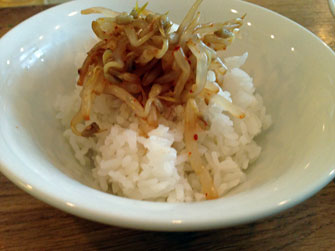
Eating at Mandoobar bears little resemblance to most restaurant experiences; it is more like like being invited to the home of a foodie friend for a Zen-like culinary ritual.
Once you have found the place, hidden behind scaffolding on a nondescript street north of the Gare Saint Lazare, you step into a surprisingly quiet room set up like a stage for chef Kim Kwangloc, who stands alone in the center, a tall, handsome, affable man in white against the backdrop of a wall composed of horizontally arranged strips of wood.
While the 12 customers seated around the counter wait patiently, he calmly prepares each dish before their eyes, stopping occasionally to change the record on a real turntable – switching from spacey Korean music to ethereal Western piano music – or to respond to a question from one of the diners. Now and then he steps back to address the whole room like a professor lecturing to his students about his passion, Korean food.
It’s all relaxed and quiet but not church-like. There are no cooking smells, thanks to an efficient extractor.
The menu is simple: meat or vegetable dumplings, tartare of beef or tuna (the latter is not available on Monday or on days when the fish isn’t up to the chef’s freshness standards), soup, salad, rice. Desserts are not available yet (Kim works alone while waiting for the arrival of a colleague from Korea to assist him).
My friend Lisa and I ordered everything the menu had to offer. Then we watched and waited, first as Kim meticulously prepared each dumpling before our eyes, scooping the filling he had prepared earlier onto round, handmade wraps (70 percent wheat flour, 30 percent sticky-rice flour), wetting the edge, folding them over and crimping them together. They were then set to steam in bamboo baskets.
Dumplings are his specialty, and he told us that while they were originally eaten only during

festivals in Korea, they have now become more commonplace as street food. Both the meat (beef and pork with tofu, chives, leeks and soy sauce) and vegetable (tofu, chives, leeks, herbs, sesame seeds, seaweed) versions were light, flavorful and delicate.
Next up was the pièce de résistance: the beef tartare. The chef took slabs of rump steak out of the fridge, cut off chunks and weighed them. He then proceeded to carve and chop the meat


by hand right in front of us before mixing it with a little soy sauce, sesame seeds, sesame oil and salt. He then sprinkled Cambodian kampot pepper on top. Each of us got a little pile of this exquisite mixture, so simple yet full of pure flavors.
It was followed by the soup (made with fermented soy sauce, with bits of tofu floating



in it), salad (dressed sprouts topped with pickled yellow radish and full of chili-pepper fire) and rice (topped with more sprouts), all of which were good but paled a bit in comparison with the first two dishes.
We didn’t try the green tea, also prepared by Kim himself in a complicated ritual, and the baekseju, a type of Korean rice wine made with herbs.
What is so special here is the great care taken by Kim in the preparation of each and every dish, and his willingness (even eagerness) to talk about the ingredients he uses and his approach to cooking.
He explained to us that he uses different types of soy sauce, and even soy paste, for different purposes, and talked about the importance of fermentation in Korean cooking (as in kimchee), adding, “It’s very difficult to get into, but once you’re into it, you’re hooked.”
Eating at Mandoobar was a peaceful, satisfying and even inspirational experience. If it were located closer to home, I would go back regularly for the dumplings and especially the tartare. I’m hooked.
Favorite